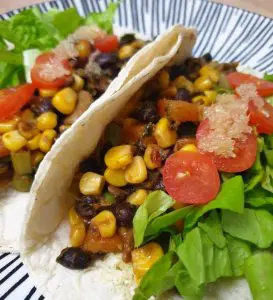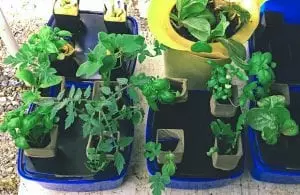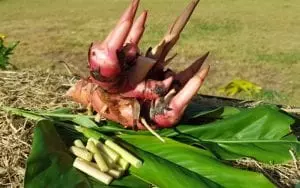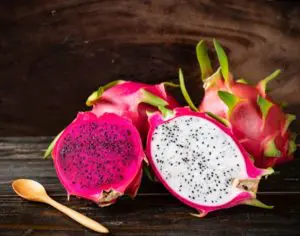Most people want a tidy lawn and garden, free of weeds. But when you pull weeds out, are you removing them successfully and permanently? Or do the same species pop up every season? We’re indoctrinated with the idea that certain weeds are locally endemic and nothing will prevent their regular reappearance.

Yet it doesn’t need to be that way! Personally, I like having weeds in my garden. I see the value in them, and recycle them throughout the garden in such a way that they benefit my vegetables and fruit trees. It’s another little way in which I can reduce landfill waste and be that bit more self-sufficient. Most weeds have numerous secondary uses: as stock feed, as dry mulch, medicinal uses, as a base for weed tea, and as living mulch. I tend to leave most of them until the point of flowering, then they get used as best suited.
1. What are Weeds?
Weeds are simply unwanted plants in a given area. They are volunteers- that means they have grown by themselves from seed dropped by previous plants. Basically, they have survived by natural selection- they are the strongest and the fittest. Which is possibly why they are sometimes so hard to get rid of. They generally have deep roots that spread fast and harvest maximum nutrients from the soil. Weeds can quickly out-compete desirable plants for space, light and soil nutrients, so these are plants that need to be managed carefully.

So, first and foremost, learn to identify the weeds in your garden- these are your nemeses! By this I mean, know which weed you don’t want, which is a helpful weed you can use, and which is just plain annoying. Local councils often have a section about weeds on their websites (if you live in southeast Queensland, here is the Brisbane City Council version), or local gardening clubs or Facebook groups may be helpful. A crop of weeds can go from germination to maturity in just a few days and quickly strangle your precious vegetables.
Make sure you know what your vegetable seedlings look like too- at every stage of their growth. The leaves of veggie seedlings can change shape and appearance during their growth cycle, and it’s very easy to mistake them for weeds, especially before they get their true leaves.
2. Wait, But Don’t Procrastinate
It’s advantageous to wait until weeds are growing vigorously before removing them. It’s often easier to get the whole weed out when they’re a decent size. Trying to pull small weeds out sometimes results in leaving the delicate roots in the soil, which means they will quickly return. Pull them out or cut them off at the peak of their growth, but before they go to seed. Weed seeds stay dormant in the ground for several years, just waiting for the ideal germination conditions. Removing the crop before flowering prevents any further seed accumulation in the soil.
People make light of procrastination these days, but it’s no joke when it comes to gardening. It’s important to keep an eye on weeds and get them at the right time- this window can be very very short. My grandmother used to say ‘do today what shouldn’t be put off until tomorrow’, and this holds especially true for the garden.

3. Ways to Remove Weeds
There are a number of ways you can remove weeds. The success or failure of them really depends on your climate and the weather at the time. Some areas and properties will have more trouble than others. On top of this, the multiplicitous effects of climate change mean constant challenges for all gardeners, as many of the worst weeds benefit from extreme weather events.
A potato fork will deal with strong weeds in dry ground. Gently lever up the whole forkful then lay the weed root on the ground. Give it a bash to shake off the soil, exposing the roots to air and light. Larger weeds that have grown through a mulch layer can be cut off. Push back the mulch, cut off the weed at the base and replace the mulch. This benefits the soil biota by leaving the rootball in place.
Smaller, less numerous weeds may be stifled by applying a thick layer of mulch. When preparing new ground for a garden bed, or if weeds have really taken over, sheet mulching with a thick layer of cardboard can help. You can re-purpose large appliance boxes for this. Just flatten them and weight the cardboard down at the corners. This works by removing the light, without which the weeds cannot grow. After a couple of weeks, take the cardboard off. You’ll see some weed remnants, which will be much easier to pull out by hand.
A specially planted cover crop can be grown then mowed over or pulled out for onsite composting. This helps with weed control, because green manures are particularly vigorous crops which out-compete weeds to a large extent. This process is best done in the season before planting. Cover crops and weeds together will both recycle & add significant nutrition to the soil- not only nitrogen, but important trace elements and minerals.

4. Use the Right Tool/s for the Job
Which tool should you use so that you don’t hurt your back, repeat the job, or strain your arms? It depends on the nature and size of the weeds in question. Weeds with tap roots need to be pried out, and those with creeping or brittle roots require different handling.
Large taproot weeds have massive root systems that go deep & are very hard to remove. A good potato fork with a solid handle is ideal for such a job, as they are good at prying out large root balls.
Many types of hoes do fantastic work too. Hoes are great to use if you want to dig over the soil while weeding. Then there are the miniature tools, which are also called hand tools. These are often sold as a set, and include a trowel, a fork and a little hoe. Hand-held tools are great for delicate weeding, small areas and weeds with creeping roots. Don’t be afraid to spend time at a hardware shop familiarising yourself with garden tools; they can really make or break your weeding workload.

5. Using Chemicals
Perhaps doing your lawn edges with a weeding chemical might be a good use of time and effort. After all, edges will need weeding and tidying every few weeks. But in your food-growing soil, it’s best to avoid this chemical warfare. After all, part of the joy of growing your own food is knowing there are no nasties going into it. Weeding might not be the most enjoyable task, but it does provide good, clean, healthy exercise in the outdoors. Getting outside and exercising in your own backyard is good for your mental and physical health in these uncertain times.
Laying weedmat over your soil is another weed prevention method. It is a low-cost solution which is easy to use, and can cover a large area quickly. It will block all light, thus preventing any further weed growth. On the downside, weedmat breaks up fairly quickly, and is often not compostable because it’s made from plastic. It can also prevent good airflow to the root zone and stop the soil taking in organic matter. So weedmat might be a good solution if used temporarily over a larger area, rather than as a long-term fixer.
As always, healthy gardening to you all- but do it today, not tomorrow!













